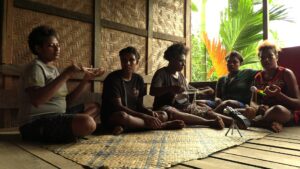Documenting Ipiko, an undescribed language of PNG

Game with strings. Photo of Natalie Immanuel, Miriam Joshua, Arisah Arai and Betty Max by Zurab Baratashvili, 2019. Click on image to access collection.
| Language | Ipiko |
| Depositor | Zurab Baratashvili |
| Affiliation | Australian National University |
| Location | Papua New Guinea |
| Collection ID | 0560 |
| Grant ID | IGS0338 |
| Funding Body | ELDP |
| Collection Status | Collection online |
| Landing Page Handle | http://hdl.handle.net/2196/3fc33c21-f48f-426b-bed0-ed784db37e04 |
Summary of the collection
The Ipiko language is spoken in Gulf province, Papua New Guinea. It has two dialects Eva and Ibigo (moribund). the project investigates both phonological and grammatical characteristics of the Ipiko language. Materials should involve the cultural usage of the language according to various naturalistically obtained texts.
Zurab Baratashvili has been collecting the data in collaboration with the Ipiko native speakers.
The collection includes both audio and video materials obtained from 15 consultants with different genders and ages.
Group represented
Ipiko is spoken in four villages (Ipiko, Pakemba, Baimuru (Biri Camp), and Naharo) in Southern New Guinea. The first villages are situated in the Pie river basin, while Naharo is in Era river basin. Ipiko and Pakemba villages solely belong to the Ipiko people.In Naharo, Ipiko live with Urama people, while in Baimuru mostly with the Purari language speakers.
Language information
The Ipiko Language is spoken in the villages of Ipiko, Pakemba, and Baimuru (Biri Camp), and Naharo (together with Urama people) situated in the Gulf province of Papua New Guinea (with about 500 speakers). The Ipiko language belongs to the Inland Gulf subgroup of the Anim group of the Trans-New Guinea family. Ipiko is the easternmost language of this branch, and is spatially separate from all its relatives, east of the mouth of the Fly River. The mysteries of how it became so separated from other Marind-Anim languages, what enabled it to gain a foothold along the Gulf coast, and what changes it may have undergone as a small enclave surrounded by unrelated languages, cannot be solved until we have detailed data on the language itself.
According to this stage of research, the typological characteristics are as follows: no case marking in the noun phrase; alignment is nominative-accusative (decided with the indexing of arguments in the verb); preclitics indexes or cross-references the A and P arguments (depends on a verb); Suffixes express various temporal and aspectual (including pluractionality) meanings. Their appearance in the verb depends on the compatibility of the morphemes; the verb can have maximally 3 suffixal and 4 preclitical / proclitical morphemes but, for example, the verb “to give” has also the prefixal slot; with some verbs, suppletive expression either agent or patient argument.
Collection contents
About 26 hours of raw audio and 4.5 hours of video recordings.
Acknowledgement and citation
To refer to any data from the collection, please cite as follows:
Baratashvili, Zurab. 2019. Documenting Ipiko, an undescribed language of PNG. Endangered Languages Archive. Handle: http://hdl.handle.net/2196/00-0000-0000-0012-6E03-D. Accessed on [insert date here].


